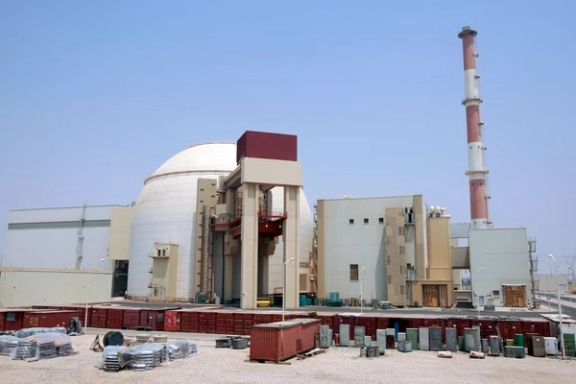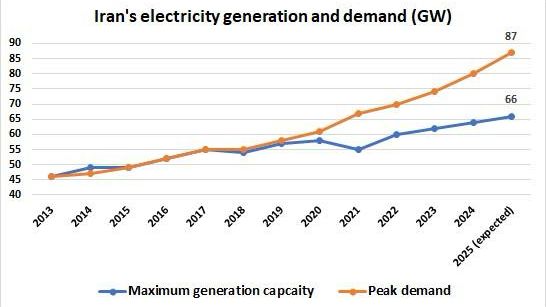Tehran leans on electricity crisis to justify nuclear drive

As nuclear talks resume and threats from the US and Israel continue, Iran’s atomic chief claims the country’s electricity shortages will be solved by building new nuclear power plants.
Nuclear power currently accounts for just one percent of Iran’s electricity generation. To make up for the country’s 25,000-megawatt shortfall, Iran would need to build 25 nuclear plants the size of Bushehr—which took 25 years to complete, even with Russian assistance.
Since its launch in 2011, the Bushehr nuclear plant has produced just 70 terawatt-hours (TWh) of electricity—worth less than $6 billion on regional markets. This modest output contrasts sharply with Iran’s extensive uranium enrichment program, which has been justified as necessary for nuclear power generation but has contributed to at least $2 trillion in direct economic losses from sanctions since 2012.
The Islamic Republic has repeatedly announced plans to develop 20,000 megawatts of nuclear power capacity, but progress has been minimal. Atomic Energy Organization chief Mohammad Eslami has reiterated the goal, describing it as a “long-term” objective.
It remains unclear why Iran, with over 300 sunny days a year and vast windy coastal and mountainous regions, has not prioritized solar and wind energy—especially given that the cost of electricity from renewables is now comparable to that of nuclear power. Despite this potential, renewables still account for just one percent of Iran’s electricity production.

By contrast, the International Energy Agency recently reported that 75% of new global power capacity in 2024 came from renewable sources, while nuclear contributed only 5% to the growth in global electricity production last year.
Iran’s electricity and gas shortages now span all seasons
For the first time, Iran is experiencing electricity and gas shortages year-round, with blackouts beginning as early as spring—where previously they were confined to the peak of summer and winter.
This year’s electricity deficit is so severe that all provinces, including Tehran, are facing scheduled 90-minute blackouts during the day. The situation in the industrial sector is even worse. A petrochemical industrialist in Tabriz told Iran International—on condition of anonymity—that his factory endures two full days of power cuts and one day of water outages each week. In addition, daily 90-minute blackouts continue to disrupt production.
These outages are happening despite spring electricity demand being 35% lower than in summer, averaging around 50,000 megawatts (MW). With peak summer demand looming, there are serious doubts about the country’s ability to cope.
While Iran’s installed power generation capacity is officially around 62,000 MW, its failure to meet even current demand suggests a deeper crisis—most likely a fuel shortage for thermal power plants, which supply over 90% of the country’s electricity.
Gas shortages have also become a year-round issue since last year, and now electricity has followed the same pattern.

According to the Ministry of Energy, around 800,000 new electricity consumers are added to the grid annually since 2010—70% of them residential. To keep pace, Iran needed to boost electricity production by about 7% per year. In practice, only half that target was achieved over the past decade, and in recent years, production growth has fallen to just 30% of planned levels.
As a result, Iran’s net annual electricity exports have fallen from 8 Twh in the mid-2010s to zero over the past two years — with domestic production no longer sufficient to meet internal consumption.
Hydropower generation
Iran’s nominal power generation capacity stands at around 94,000 megawatts (MW), but only 62,000 MW is actually operational. The gap is due to the decommissioning of aging thermal plants and reduced output from hydroelectric facilities amid ongoing drought conditions.
In an attempt to mitigate the electricity shortfall, the government increased hydropower production by 25% over the past two years. However, this came at a cost: water levels in key dams—some of which supply drinking water to major cities, including Tehran—have dropped to just 7–10% of capacity. As a result, the country’s ability to rely on hydropower has been nearly exhausted.
Thermal power plants
Over the past 15 years, nearly all growth in Iran’s electricity supply has come from thermal power plants running on natural gas, fuel oil (mazut), and diesel. These plants now generate over 90% of the country’s electricity.
However, Iran is facing critical fuel shortages year-round, making it increasingly difficult to supply these plants. Compounding the problem, many of the facilities are outdated and inefficient, operating well below global standards.

It’s not just the low efficiency of power plants that is driving the electricity crisis. According to an official report from the Ministry of Energy, 13% of the electricity produced is lost in the country’s old and deteriorating transmission and distribution network.